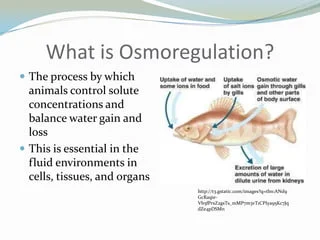
ABSTRACT:
In this article, we will discuss about the methods of osmoregulation in vertebrates. It is the process of balance the body fluids to maintain their concentration. Some vertebrates are osmoconformers (they can not regulate the concentration of body fluids according to external environment). Most vertebrates are osmoregulators (they can regulate the concentration of body fluids according to external environment). We will discuss about the mechanisms of osmoregulation in vertebrates.
INTRODUCTION:
Osmoregulation is the process by which vertebrates maintain the balance of water and solutes within their bodies, ensuring optimal physiological function. This intricate mechanism allows vertebrates to adapt to various environments, from freshwater to marine habitats. This article explores the fascinating world of osmoregulation in vertebrates, highlighting the key mechanisms and adaptations involved.
1. KIDNEYS-THE MASTER REGULATORS:
The kidneys play a central role in osmoregulation, acting as the primary organs responsible for maintaining water and electrolyte balance. In vertebrates, the kidneys filter blood, reabsorb essential substances, and excrete waste products. The process of filtration, reabsorption, and secretion allows for the regulation of water and solute levels in the body.

2. FRESHWATER ADAPTATIONS:
Freshwater vertebrates face the challenge of maintaining electrolyte balance in a hypotonic environment. To prevent excessive water uptake, freshwater fish have specialized adaptations. They actively take in salts through their gills and excrete large volumes of dilute urine. Additionally, they possess specialized cells in their gills that actively transport ions, such as sodium and chloride, back into the body.

3. MARINE ADAPTATIONS:
Marine vertebrates, on the other hand, face the challenge of preventing water loss and maintaining electrolyte balance in a hypertonic environment. They have evolved mechanisms to conserve water and excrete excess salts. They have specialized chloride cells in their gills that actively excrete excess salts, while their kidneys produce small volumes of concentrated urine. Additionally, some marine reptiles, such as sea turtles, have specialized glands that excrete excess salt through their tears.

4. TERRESTRIAL ADAPTATIONS:
Terrestrial vertebrates face the challenge of preventing water loss in dry environments. Reptiles, birds, and mammals have evolved various adaptations to conserve water. They have highly efficient kidneys that produce concentrated urine, minimizing water loss. Additionally, they have specialized structures, such as the loop of Henle in the kidneys, which allows for the reabsorption of water. Some desert-dwelling animals, like kangaroo rats, can also obtain water from metabolic processes, reducing their reliance on external water sources.

CONCLUSION:
Osmoregulation is a vital process that allows vertebrates to maintain water and electrolyte balance in diverse environments. The kidneys, along with specialized adaptations in the gills, glands, and other organs, play a crucial role in regulating osmotic balance. Understanding the mechanisms of osmoregulation in vertebrates not only provides insights into their physiological adaptations but also sheds light on the remarkable diversity of life on our planet. As research continues, further discoveries in osmoregulation may contribute to advancements in medical and environmental sciences.
REFERENCES:
Evans, D. H. (2008). Osmoregulation and Excretion. In The Physiology of Fishes (3rd ed., pp. 207-246). CRC Press. https://www.taylorfrancis.com/books/mono/10.1201/9781420058093/physiology-fishes-james-claiborne-david-evans
Marshall, W. S., & Grosell, M. (2006). Ion Transport, Osmoregulation, and Acid-Base Balance. In Fish Physiology (Vol. 24, pp. 177-230). Academic Press. https://www.ncbi.nlm.nih.gov/pmc/articles/PMC8098666
Schmidt-Nielsen, K. (1997). Osmoregulation. In Animal Physiology: Adaptation and Environment (5th ed., pp. 273-309). Cambridge University Press. https://books.google.com.np/books?id=Af7IwQWJoCMC&printsec=frontcover#v=onepage&q&f=false

